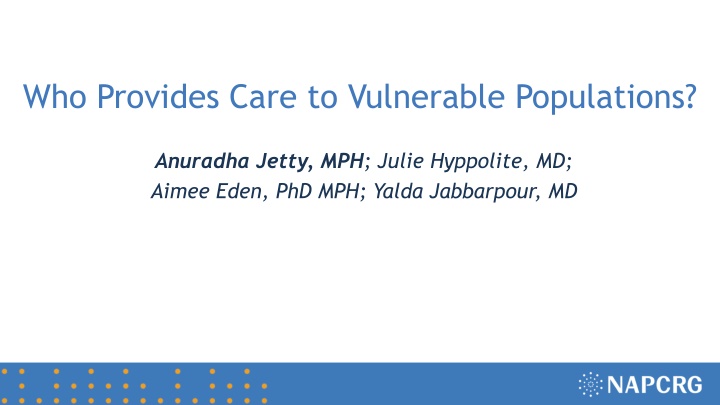
Care for Vulnerable Populations: Research Insights
Explore a study on family physicians serving vulnerable populations, revealing differences by demographics. Discover implications for clinical practice in reducing healthcare disparities and promoting cultural competency.
Download Presentation

Please find below an Image/Link to download the presentation.
The content on the website is provided AS IS for your information and personal use only. It may not be sold, licensed, or shared on other websites without obtaining consent from the author. If you encounter any issues during the download, it is possible that the publisher has removed the file from their server.
You are allowed to download the files provided on this website for personal or commercial use, subject to the condition that they are used lawfully. All files are the property of their respective owners.
The content on the website is provided AS IS for your information and personal use only. It may not be sold, licensed, or shared on other websites without obtaining consent from the author.
E N D
Presentation Transcript
Who Provides Care to Vulnerable Populations? Anuradha Jetty, MPH; Julie Hyppolite, MD; Aimee Eden, PhD MPH; Yalda Jabbarpour, MD
The Research Question Vulnerable populations face difficulties in healthcare access and are at higher risk of experiencing health disparities. Family medicine educators prepared family physicians to work with under-resourced and marginalized populations. Are there differences in the rates of family physicians working with vulnerable populations by race or gender?
Research Design and Method Cross-sectional study that identified key factors associated with family physicians serving vulnerable populations. We used the American Family Board of Family Medicine Certification Application Survey data (2016-2019). Vulnerable population were defined as uninsured, insured by Medicaid, homeless, non-English speaking, racial or ethnic minority and traditionally underserved populations. Outcome: Binary measure of family physicians provision of care to vulnerable populations ( 50% of patient panel consisted of vulnerable populations). We performed univariate, bivariate and logistic regressions.
What the Research Found Of the total FPs (N=29,936) in the study sample, 19% reported provision of care to vulnerable populations. Female compared to male, and younger compared to older family physicians were more likely to serve vulnerable populations. Black and Hispanic family physicians were thrice as likely as White family physicians to serve vulnerable populations.
What this means for Clinical Practice Our study findings have implications on access to healthcare for vulnerable populations. Increasing diversity in physician workforce, exposing trainees to settings with vulnerable populations and increasing cultural competency training for all clinicians can help bolster the family physician workforce in these settings and reduce healthcare disparities.






















